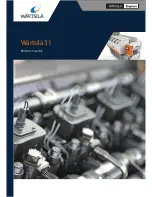
Important Safe Operation Practices
3
2
WARNING!
This symbol points out
important safety instructions which, if
not followed, could endanger the
personal safety and/or property of yourself and
others. Read and follow all instructions in this
manual before attempting to operate this
machine. Failure to comply with these
instructions may result in personal injury. When
you see this symbol.
HEED ITS WARNING!
DANGER:
This machine was built to be
operated according to the safe
operation practices in this manual. As
with any type of power equipment, carelessness
or error on the part of the operator can result in
serious injury. Failure to observe the following
safety instructions could result in serious injury
or death.
Training
1.
Read, understand and follow all
instructions on the engine and in the
manual(s) before attempting to assemble
and operate. Keep this manual in a safe
place for future and regular reference and
for ordering replacement parts.
2.
Be familiar with all controls and their
proper operation. Know how to stop the
engine and disengage them quickly.
3.
Never allow children under 14 years of
age to operate the engine. Children 14
and over should read and understand the
instructions and safe operation practices
in this manual and on the engine and be
trained and supervised by an adult.
4.
Never allow adults to operate the machine
without proper instruction.
5.
Keep the area of operation clear of all
persons, particularly small children and
pets. Stop machine if anyone enters the
area.
CALIFORNIA PROPOSITION 65
WARNING!
Engine Exhaust, some
of its constituents, and certain
vehicle components contain or
emit chemicals known to State of California
to cause cancer and birth defects or other
reproductive harm.
Preparation
1.
Wear sturdy, rough-soled work shoes and
close fitting slacks and shirts. Loose fitting
clothes or jewelry can be caught in the
moving parts. Never operate the machine
in bare feet or sandals.
2.
Disengage clutch levers and shift (if
equipped) into nuetral (“N”) before
starting the engine.
3.
Never leave the engine running while
unattended.
4.
Never attempt to make any adjustments
while the engine is running, except
where specifically recommended in the
operator’s manual.
Safe Handling of Gasoline:
To avoid personal injury or property damage,
use extreme care in handling gasoline. Gasoline
is extremely flammable and the vapors are
explosive. Serious personal injury can occur
when gasoline is spilled on yourself and/or your
clothes which can ignite. Wash your skin and
change clothes immediately.
1.
When adding fuel, turn engine OFF and
let engine cool at least 2 minutes before
removing the gas cap.
2.
Fill fuel tank outdoors or in well ventilated
area.
3.
Use only an approved gasoline container.
4.
Never fill containers inside a vehicle or on
a truck or trailer bed with a plastic liner.
Always place containers on the ground
away from your vehicle before filling.
5.
If possible, remove gas-powered
equipment from the truck or trailer and
refuel it on the ground. If this is not
possible, then refuel such equipment on
a trailer with a portable container, rather
than from a gasoline dispenser nozzle.
6.
Keep the nozzle in contact with the rim of
the fuel tank or container opening at all
times until fueling is complete. Do not use
a nozzle lock-open device.
7.
Do not overfill fuel tank. Fill tank to full
as indicated by the fuel level indicator
installed inside of the fuel tank. Do not
over-fill to allow space for fuel expansion.
On some models, a fuel level indicator
may NOT be present, in this instance, fill
the tank no more than 1/2 inch below the
bottom of the filler neck to allow space for
fuel expansion.
8.
Replace fuel cap and tighten until the cap
ratchets.
9.
If gasoline is spilled, wipe it off the engine
and the equipment. Move the machine
to another area. Wait five minutes before
starting the engine.
10.
To reduce fire hazards, keep the machine
free of grass , leaves or other debris
build up. Clean up oil or fuel spillage and
remove any fuel-soaked debris.
11.
Keep gasoline away from sparks, open
flames, pilot lights, heat, and other
ignition sources.
12.
Never fuel equipment indoors because
flammable vapors will accumulate in the
area.
13.
Extinguish all cigarettes, cigars, pipes, and
other sources of ignition.
14.
Check fuel line, tank, cap, and fittings
frequently for cracks or leaks. Replace if
necessary.
Operation
1.
When starting the engine, make sure spark
plug, muffler, and fuel cap are in place.
2.
Do not crank engine with spark plug
removed.
3.
If fuel spills, wait until it evaporates before
starting engine.
4.
Allow muffler, engine cylinder, and fins to
cool before touching.
5.
Keep children away from hot or running
engines. They can suffer burns from a hot
muffler.
6.
Remove accumulated combustibles from
muffler and cylinder area.
7.
Operate equipment with all guards in
place.
8.
Keep hands and feet away from rotating
parts.
9.
Tie up long hair and remove jewelry.
10.
Do not wear loose-fitting clothing,
dangling drawstrings or items that could
become caught.
11.
When starting the engine, pull cord slowly
until resistance is felt, then pull rapidly.
12.
Remove all external equipment/engine
loads before starting engine.
13.
Direct coupled equipment components
such as, but not limited to blades,
impellers, pulleys, sprockets, etc., must be
securely attached.
Maintenance & Storage
1.
Keep the engine in safe working order
2.
Allow the engine to cool at least five
minutes before storing. Never tamper
with safety devices. Check their proper
operation regularly.
3.
Check bolts and screws for proper
tightness at frequent intervals to keep the
engine in safe working condition. Visually
inspect the engine for any damage.
4.
Before cleaning, repairing or inspecting;
stop the engine and make certain all
moving parts have stopped. Disconnect
the spark plug wire and ground it against
the engine to prevent unintended
starting.




































